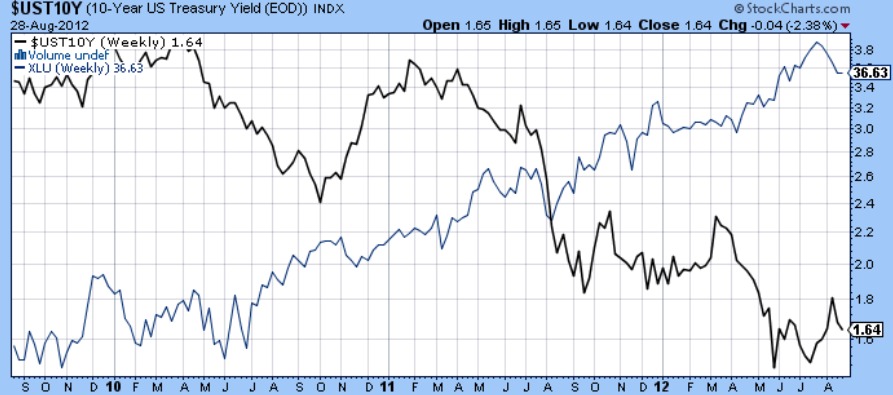By Rohan Reddy, research analyst with Global X ETFs
With aggressive timelines to reach net-zero carbon emissions and global energy consumption expected to increase by 50% through 2050, governments are exploring all options in the next generation of power production.1
While much of the focus has been on renewables like solar and wind, there may still be a critical role for nuclear energy in the global energy mix, given that it’s clean, reliable, and yes, safe.
Importantly, nuclear power is gradually shedding the stigma attached to it, helped by significant improvements in technology and safety measures. And as it gains broader acceptance, we believe nuclear energy is raising the investment profile of uranium, its key fuel input.
Key Takeaways
- Nuclear power emits zero greenhouse gas emissions during operations, making it a viable energy option for net-zero climate ambitions.
- Nuclear production is more reliable than other renewables, and large population centers with rising energy needs like China and India are taking notice.
- With supply deficits expected to persist, leading indicators like ETF flows suggest that investor sentiment towards the uranium market is bullish.
Energy Transition
Meeting the world’s growing power needs while simultaneously reducing carbon emissions presents difficult challenges for policymakers. Compounding the issue is finding ways to power the 55% percent of the world’s population living in dense urban areas.2
While proven renewables likes solar and wind are becoming increasingly economical, their larger footprint, intermittent power production, and difficulty in rapidly scaling requires other clean solutions to diversify the world’s energy mix. Nuclear energy may be the solution, as a clean, high output, and reliable power source.
Similar to solar and wind, nuclear fission reactors produce no greenhouse gas emissions during operation. But even when accounting for total carbon emissions (such as in the building of a nuclear power plant or solar panels) they have lower carbon emissions than many other renewables.
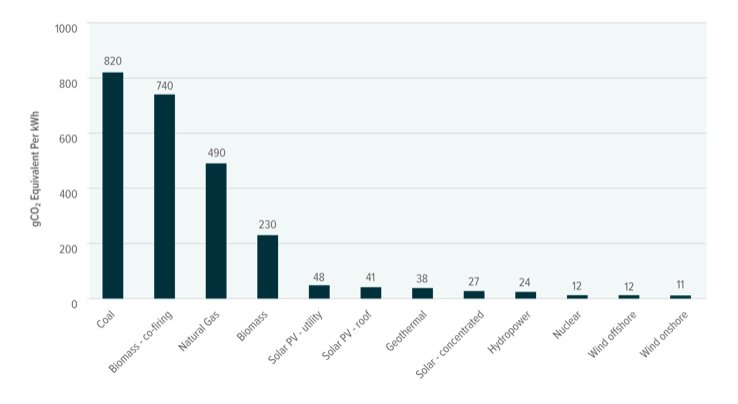
Dependable Source
Nuclear is also more dependable than many other power sources. Renewables like solar and wind depend on variable climate conditions to power their panels and turbines, and at many points throughout the day and year may not produce much energy at all.
The intermittent outages make it difficult for them to function as the sole provider of a nation’s power needs. Conversely, the U.S. Energy Information Administration (EIA) reports that nuclear operates at full capacity 93.5% of the time, making it the most reliable energy source by far.
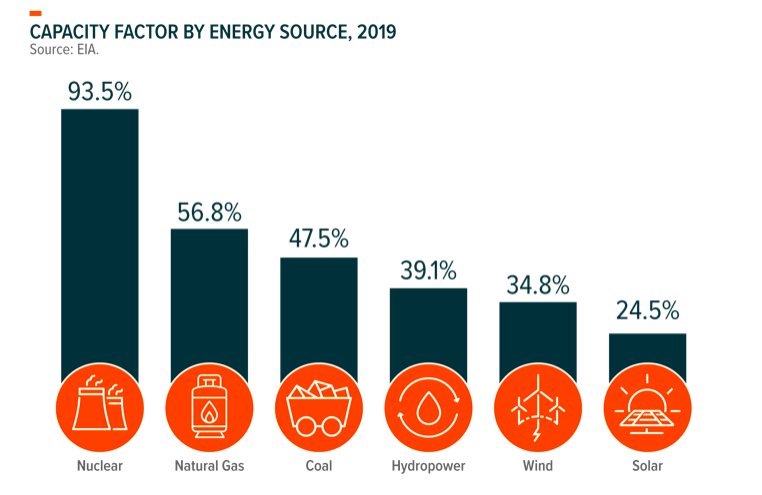
Government Backing
In the quest for clean energy, recent government-led nuclear power initiatives focus on three main areas: 1) developing more or less advanced reactors tailored to need, 2) extending the lives of existing plants, and 3) building traditional reactors.
A primary benefit of the latest reactor technology is that they can be designed to meet specific end-user requirements, such as reducing water and waste usage. In addition, their upfront capital requirements are lower than traditional reactors in absolute terms, they can be compatible with other energy sources and they come with enhanced safety features.3
Small-module reactors (SMRs) are the most prominent example of these new reactor types. SMRs have all the benefits of traditional nuclear power plants, but they require less planning and capital needs than their traditional counterparts, making them particularly suitable for smaller energy projects.
The world’s first active SMR is a floating barge located in the Arctic that powers the Russian town of Pevek. It offers a glimpse of how SMR technology can be used, particularly in rural areas that rely on fossil fuels. Currently, there are more than 70 SMR designs at various stages of development in 17 countries.
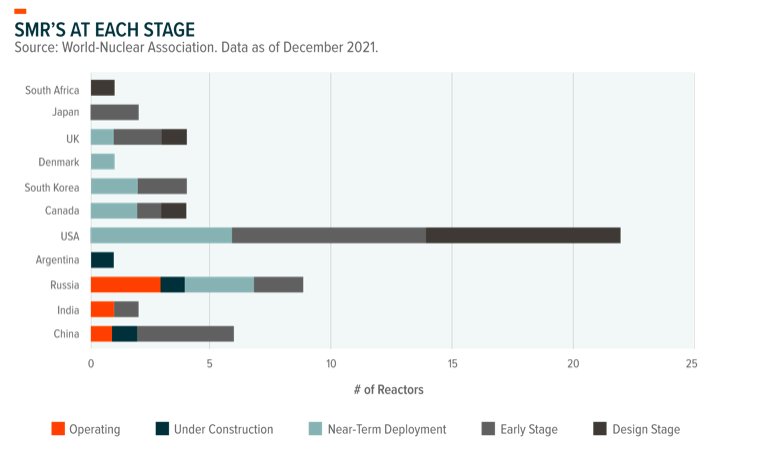
Life Cycle
Extending the life cycle of an existing nuclear plant is another option for governments, as it’s significantly less capital-intensive than building a new one. Importantly, plants with lifetime extensions are also much more cost-competitive with low carbon-generating technologies.
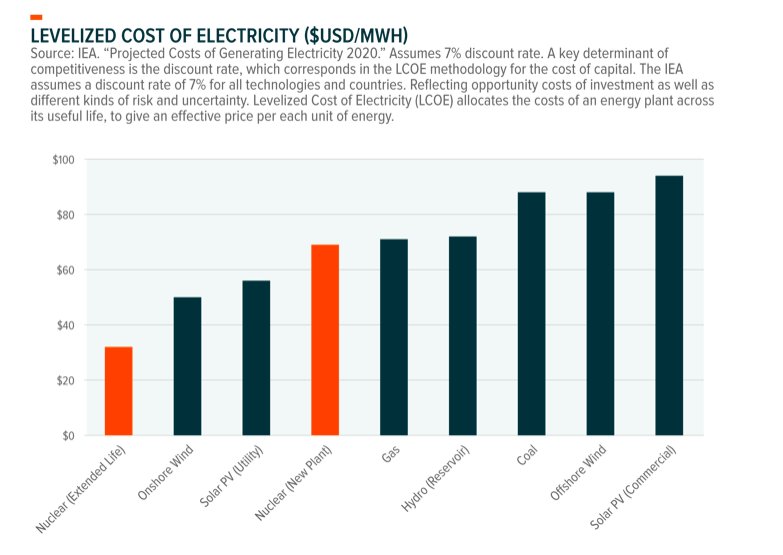
The U.S. has some of the oldest nuclear reactors in the world with an average age of 39 years. An estimated 90% of U.S. nuclear plants have received extensions to increase their operating life from 20 to 40 years over the last few decades.
Recently, the Nuclear Regulatory Committee (NRC) started extending licenses and giving plants a potential life cycle of 80 years. Over 20% of the U.S.’s nuclear reactors now plan to operate for up to 80 years. In December 2019, two nuclear reactor units in Florida were the first to be cleared by the NRC to operate for the 80-year life cycle.4
The pro-nuclear energy sentiment is even stronger in developing countries. Asia is a leading hub for new reactor construction. China has 18 traditional reactors under construction, India has six and South Korea has four. Globally, over 50 reactors are under construction in 19 different countries. With 445 reactors in operation around the world today, these new builds represent meaningful growth for nuclear power.5
Uranium Prices
Uranium provides the fuel to nuclear power plants. But many of the world’s largest uranium miners, including Cameco and Kazatomprom, tapered production or shuttered mines completely as the global economy came to a standstill at the start of the pandemic.
These decisions flipped a deeply oversupplied market into one that quickly became undersupplied. Now with demand increasing, the supply deficit is unlikely to dissipate soon due to the uranium production cycle.
Unlike other commodities, uranium requires a longer and more extensive production timeline. Utilities must source uranium 12–24 months before its expected use.
Producers like Cameco and Kazatomprom, which together represented 28% of global uranium production in 2020, are not expected to increase production for the next 1–2 years.6 That timeline suggests the earliest we can expect materially higher production output is between 2024 and 2026, which could provide support for higher prices.
To read this post that first appeared on Feb. 18 in its entirety, click here and visit the Global X ETF blog.
Photo Credit: Lennart Tange via Flickr Creative Commons
FOOTNOTES
Endnotes:
1. EIA Report. “EIA projects nearly 50% increase in world energy use by 2050, led by growth in renewables”
2. United Nations. “UN World Urbanization Prospects”. Data as of November 2019.
3. IAEA. “What are Small Modular Reactors (SMRs)?”
4. IAEA. “Going Long Term US Nuclear Power Plants Could Extend Operating Life to 80 Years”
5. Statista.
6. World Nuclear. “World Uranium Mining Production”. Data as of September 2021.
7. Sprott. Data as of 12/20/21.
8. Statista.
9. Cameco, Solactive, Bloomberg. Uranium equities measured by the Solactive Global Uranium and Nuclear Components Index.
DISCLOSURE
Index returns are for illustrative purposes only and do not represent actual fund performance. Index performance returns do not reflect any management fees, transaction costs or expenses. Indices are unmanaged and one cannot invest directly in an index. Past performance is not a guarantee of future results.
Shares of ETFs are bought and sold at market price (not NAV) and are not individually redeemed from the Fund. Brokerage commissions will reduce returns.
Investing involves risk, including the possible loss of principal. International investments may involve risk of capital loss from unfavorable fluctuation in currency values, from differences in generally accepted accounting principles, or from economic or political instability in other nations.
Emerging markets involve heightened risks related to the same factors as well as increased volatility and lower trading volume. Narrowly focused investments may be subject to higher volatility. There are additional risks associated with investing in Uranium and the Uranium mining industry. URA is non-diversified.
Carefully consider the funds’ investment objectives, risks, and charges and expenses. This and other information can be found in the fund’s full or summary prospectus, which may be obtained at globalxetfs.com. Please read the prospectus carefully before investing.



